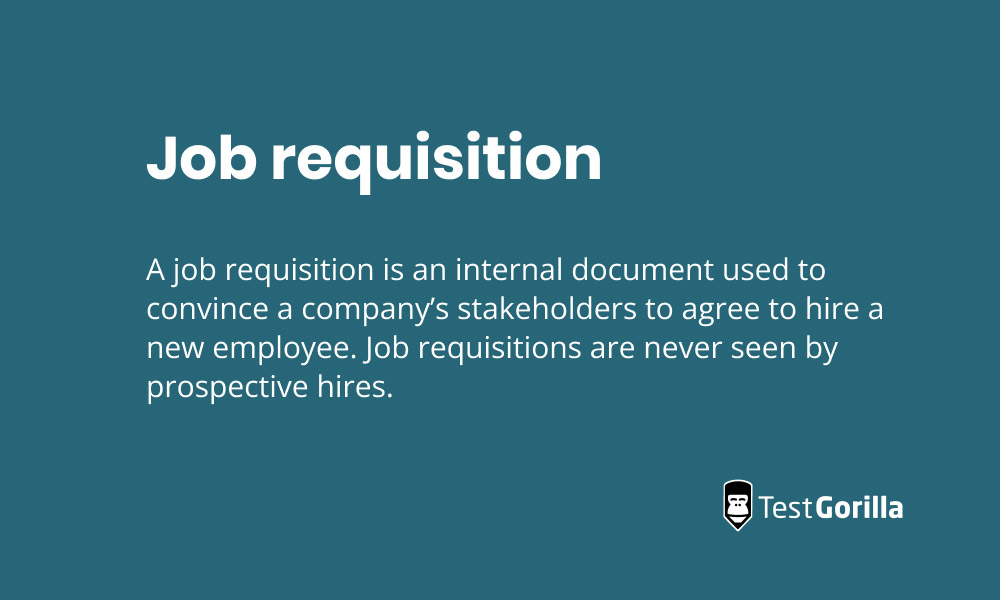Need to make a new hire? Maybe you’re after a talented developer to add to your team or a freelance writer to increase the bandwidth of your marketing team. Or perhaps you’re just looking to fill a position while one of your human resources team member is on maternity leave. Whatever the case, it’s time to write a job requisition.
Regardless of your reason behind adding a team member, it won’t happen until you get company stakeholders to sign off on the position. That’s where job requisitions come in.
This comprehensive guide to job requisition requests will fill you in on the anatomy of a great job requisition. We're also going to do a deep dive into how to write one to ensure other decision-makers in the company:
understand the value of the proposed role,
realize the urgent need to hire and fill the position, and
agree to recruit someone new.
Let's get to it!
Table of contents
What is a job requisition?
Before we get into the nitty-gritty of the job requisition process, what does a job requisition mean?
A job requisition, or a job req, refers to a formal organizational document that hiring managers or department managers use to request new employees.
When creating a job requisition document, the goal is to make a business case for the new role and provide details on the position in question — from position title to the new hire’s job duties. It outlines why a new hire is needed, what the recruitment process would be like, and provide information on the potential budget required to make it happen
What is the difference between a job requisition, job description, and job posting?
A job requisition can often be confused with a job posting and a job description. While they are related, each term serves a distinct purpose. Here's a quick look of their differences:
Term | Purpose | Content and Scope | Audience |
|---|---|---|---|
Job Requisition | Initiates the hiring process; an internal document | Position title, department, responsibilities, required qualifications, and sometimes desired candidate profile | Internal - Hiring manager or department |
Job Description | Provides a comprehensive overview of a specific job role within the organization | Primary responsibilities, duties, tasks, and required qualifications | Internal and potential candidates |
Job Posting | External announcement of a specific job opening or new position to job seekers | Job title, company information, responsibilities, qualifications, and application instructions | External - Job seekers; posted on various platforms |
A job requisition is an internal document that initiates the hiring process. It is typically generated by the hiring manager or department requesting the need for a new employee. A job requisition form outlines the position title, department, responsibilities, required qualifications, and sometimes the desired candidate profile. It is a formal request to fill a vacant or newly created position within the organization. Job requisitions are never seen by prospective hires.
A job description is a written document that provides a comprehensive overview of a specific job role within an organization. It outlines the position's primary responsibilities, duties, tasks, and required qualifications. Job descriptions aim to provide potential candidates with a clear understanding of what the job entails, including its expectations, reporting structure, and any relevant details. It serves as a foundational document for the recruitment and selection process.
A job posting is an external document meant to announce or communicate a specific new position or job opening to job seekers. It is created based on the job description and typically includes key details about the position, such as the job title, company information, job responsibilities, required qualifications, and application instructions. Job postings are often published on various platforms, such as job boards, company websites, social media, or professional networking sites.
In short, a job requisition is an internal request to initiate the hiring process, a job description is a detailed description of a specific job role, and a job posting is an external announcement that advertises a job opportunity to potential candidates.
Why are job requisitions important in the hiring process?
When hiring a new employee, job requisitions are crucial as they require agreement from each department (e.g. finance department, hr department, other executives) Thus, job requisitions must be convincing enough to make a case for why a new job position is necessary.
Next, job requisitions are typically forwarded to either an internal recruiter or an hr business partner who use them as a reference during the talent acquisition process.
Job requisition form essentials
What does a job requisition include? While the specific content may vary in your job requisition form based on organizational needs and goals, here are the key elements that are typically included in a job requisition form:
Information about the position
Job title: The specific title of the position being requested.
Department: The department or team within the organization where the position will be located.
Reporting structure: Details about who the position will report to and the position's role within the organizational hierarchy.
Approval process: Information about the approval process for new hires.
Job description
An overview of the role's primary responsibilities and duties.
Required qualifications of ideal candidate: Educational background, work experience, required skills, certifications, and any other relevant attributes needed for the role.
Employment details
Employment type: Specify whether the position is full-time, part-time, temporary, or permanent.
Work schedule: The expected working hours, shifts, or any special arrangements. Will the role be full-time or part-time? Mention the number of hours per week required for a part-time role.
Duration. Include whether the assignment is permanent or temporary. If it’s a temporary contract, the end date should be defined.
Contract type. State whether you wish to hire an employee or a contract worker. This will have an impact on the job scope and any additional benefits you may or may not need to pay.
Location: The physical location where the employee will work, or whether it's a remote or hybrid role.
Budget and compensation
Salary range: Provide the expected salary range or budget for the position. Stating the approximate salary range for the role will help stakeholders conceptualize budget requirements for the new role.
Benefits: Outline any additional benefits or perks that will be offered to the employee.
Pro tip: Stakeholders will be keenly interested in the cost of hiring a new employee. Be transparent about budget requirements and be sure to back up your assertions with evidence of why that particular budget is required. For example, you may justify your budget as the standard going rate for a role, or you may argue you need a more sizable budget to attract the best talent for a role requiring niche, high-level skills.
Justification and business case
Requisition reason: Explain the need for the position, such as expansion, project requirements, the need to meet business demands, or replacing a departing employee.
Business impact: Describe how filling the position will contribute to the organization's goals and objectives.
Approval and authorization
Signature and date: The hiring manager or department manager requesting the position should sign and date the requisition form.
Additional approvals: If required, include spaces for higher-level approvals, such as HR or senior management.
Recruitment strategy
Recruitment channels: Mention the preferred channels for sourcing candidates, such as job boards, company website, external advertisement, or referrals. You might also want to mention other recruitment tools that the recruitment team will need like applicant tracking system, pre-employment testing, etc.
Recommended reading: Your hiring team’s guide to recruitment tools
Timeline and urgency
Preferred start date: The ideal or target date for the new employee to begin work.
Urgency: Indicate whether the position needs to be filled urgently or if there is a flexible timeline.
Additional notes or comments
Any other relevant information or special considerations related to the position such as what the interview process would be like.
With all of these elements in your job requisition form, you can provide all the necessary information for HR and recruitment teams to a structured, more efficient, and transparent hiring process.
How to write a persuasive job requisition
Now we’ve got the essentials out of the way, it’s time to get down to the nitty-gritty components you need to include in a convincing job requisition.
Speak in terms of each department's interests
A key part to remember in the job requisition process is you need to address each team’s key anxieties around hiring someone new while highlighting how they’ll benefit from the new hire.
For example, to win over the finance team and get them to part with company money, you’ll need to make a strong case for why there’s room for this new hire in your company’s budget. Show them how the new addition will be a net gain rather than an expense.
In comparison, the HR team may be more concerned with gaps in your workforce’s skill sets. Will an unfulfilled position mean that certain tasks go unmanaged? How will this impact the company and its reputation with customers or clients?
Focus on each department’s key interests and responsibilities. Show them how the new team member will meet organizational goals and what they risk by refusing to onboard a new employee.
Give them the numbers and metrics
For many organizations, figures and metrics are so much more persuasive than words alone. To make your job requisition more convincing, talk in terms of numbers and metrics.
What quantifiable, measurable difference will the suitable candidate make to the company? Which metrics will they need to hit? What will they achieve in 60 days? What will they accomplish in one year? How will they impact the revenue generated by the company?
Persuade off the page
A persuasive job requisition begins off the page. Get stakeholders’ buy-in before you share your job requisition and start the hiring process. Discussing the benefits and drawbacks of hiring someone new beforehand can give you insights into what each department’s biggest concerns and interests are, ensuring you appeal to each of them in your document.
Discussing costs beforehand also ensures that none of the decision-makers feel blindsided by any unexpected costs which will increase your chances of receiving each “yes” you need.
Ace your next job requisition
The job requisition process don’t have to be intimidating. With the above elements, it’s easy to get each department to want to say yes to your proposal for a new hire.
Now that writing a job requisition has been taken care of, your next step is to make sure that your hiring needs and goals are skills-focused. Why? Resumes can be unreliable and dependent on interpretation as well as bias.
Learn more about skills-based hiring through the following guides:
How to adopt skills-based hiring practices in your organization
Skills-based success: 10 case studies for skills-based hiring
Related posts
Hire the best candidates with TestGorilla
Create pre-employment assessments in minutes to screen candidates, save time, and hire the best talent.
Latest posts
The best advice in pre-employment testing, in your inbox.
No spam. Unsubscribe at any time.

Hire the best. No bias. No stress.
Our screening tests identify the best candidates and make your hiring decisions faster, easier, and bias-free.
Free resources
This checklist covers key features you should look for when choosing a skills testing platform
This resource will help you develop an onboarding checklist for new hires.
How to assess your candidates' attention to detail.
Learn how to get human resources certified through HRCI or SHRM.
Learn how you can improve the level of talent at your company.
Learn how CapitalT reduced hiring bias with online skills assessments.
Learn how to make the resume process more efficient and more effective.
Improve your hiring strategy with these 7 critical recruitment metrics.
Learn how Sukhi decreased time spent reviewing resumes by 83%!
Hire more efficiently with these hacks that 99% of recruiters aren't using.
Make a business case for diversity and inclusion initiatives with this data.




















